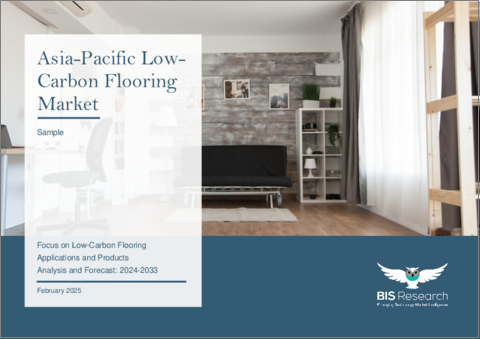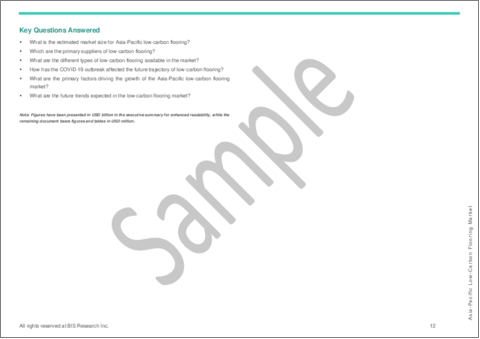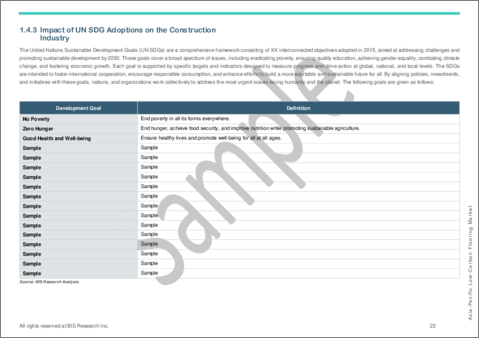|
|
市場調査レポート
商品コード
1657957
アジア太平洋の低炭素フローリング市場:用途・製品別の分析・予測 (2024-2033年)Asia-Pacific Low-Carbon Flooring Market: Focus on Low-Carbon Flooring Applications and Products - Analysis and Forecast, 2024-2033 |
||||||
カスタマイズ可能
|
|||||||
| アジア太平洋の低炭素フローリング市場:用途・製品別の分析・予測 (2024-2033年) |
|
出版日: 2025年02月19日
発行: BIS Research
ページ情報: 英文 70 Pages
納期: 1~5営業日
|
- 全表示
- 概要
- 図表
- 目次
アジア太平洋の低炭素フローリングの市場規模は、2024年の150億6,000万米ドルから、予測期間中はCAGR 8.62%で堅調に推移し、2033年には317億1,000万米ドルに達すると予測されています。
持続可能な建材を奨励する政府の厳しい規制と環境意識の高まりにより、アジア太平洋の低炭素フローリング市場は急速に拡大しています。持続可能性と二酸化炭素削減へのコミットメントを果たすため、企業や消費者は環境に優しい床材を選択するようになっています。また、技術開発の進展により、入手しやすく手頃な価格帯の製品も増えており、市場開拓はさらに進んでいます。
市場イントロダクション
| 主要市場統計 | |
|---|---|
| 予測期間 | 2024-2033年 |
| 2024年評価 | 150億6,000万米ドル |
| 2033年予測 | 317億1,000万米ドル |
| CAGR | 8.62% |
アジアの低炭素フローリング市場は、建設による環境への悪影響を最小限に抑えることに注力する中で急速に拡大しています。持続可能性と気候変動に対する意識の高まりから、グリーンビルディングへの取り組みの一環として、消費者や企業の間で低炭素フローリングの人気が高まっています。エネルギー効率と二酸化炭素排出量に関する法律の厳格化により、低炭素フローリングは、特に商業、工業、住宅分野の建築プロジェクトにおいて人気の高い選択肢となっています。
技術開発の結果、経済的で環境に優しい新しい床材が誕生しました。その中には、天然繊維、バイオベース製品、リサイクル素材など、性能を犠牲にすることなく二酸化炭素排出量を削減する床材も含まれています。さらに、LEED (Leadership in Energy and Environmental Design) やWELLなどのグリーンビルディング認証の人気が高まっていることも、低炭素フローリングオプションの需要を後押ししています。
エネルギー効率が高く、環境に優しい建材は、アジア太平洋の都市化率の上昇に伴い、これまで以上に重要になっています。持続可能な材料の使用を促進する政府の政策やインセンティブにより、市場は拡大しています。世界のグリーンビルディングの動向に合わせて、持続可能性を優先し、環境への影響を軽減する企業が増えるにつれて、アジア太平洋の低炭素フローリング市場は成長すると予想されます。
当レポートでは、アジア太平洋の低炭素フローリングの市場を調査し、主要動向、市場影響因子の分析、法規制環境、技術開発・特許の動向、市場規模の推移・予測、各種区分・主要国別の詳細分析、競合情勢、主要企業のプロファイルなどをまとめています。
市場の分類
セグメンテーション1:エンドユーザー産業別
- 住宅
- 非住宅
セグメンテーション2:素材タイプ別
- リノリウム
- 木材
- コルク
- 竹
- 石材
- その他
セグメンテーション3:デザインタイプ別
- シート
- カーペット
- ブロック・タイル
セグメンテーション4:タイプ別
- バージン製品
- リサイクル製品
セグメンテーション5:地域別
- アジア太平洋:中国・日本・インド・韓国・オーストラリア・その他
目次
エグゼクティブサマリー
範囲と定義
第1章 市場
- 動向:現在および将来の影響評価
- トレンド:概要
- 建設業界の概要
- 炭素削減の取り組み
- サプライチェーンの概要
- バリューチェーン分析
- 価格予測
- 研究開発レビュー
- 特許出願動向(国別、企業別)
- 規制状況
- 市場力学の概要
- 市場促進要因
- 市場抑制要因
- 市場機会
第2章 地域
- 地域別概要
- アジア太平洋
- 地域概要
- 市場成長推進因子
- 市場課題
- 用途
- 製品
- 中国
- 日本
- インド
- 韓国
- オーストラリア
- その他
第3章 市場:競合ベンチマーキング・企業プロファイル
- 次なるフロンティア
- BUILDSTAR PROJECTS PVT. LIMITED
- NOX CORP.
- CFL Holding Limited
第4章 調査手法
List of Figures
- Figure 1: Asia-Pacific Low-Carbon Flooring Market (by End-Use Industry), 2023, 2026, and 2033
- Figure 2: Asia-Pacific Low-Carbon Flooring Market (by Material Type), 2023, 2026, and 2033
- Figure 3: Asia-Pacific Low-Carbon Flooring Market (by Design Type), 2023, 2026, and 2033
- Figure 4: Asia-Pacific Low-Carbon Flooring Market (by Type), 2023, 2026, and 2033
- Figure 5: Low-Carbon Flooring Market, Recent Developments
- Figure 6: Supply Chain and Risks within the Supply Chain
- Figure 7: Low-Carbon Flooring Market, Pricing Forecast, ($USD/per square foot), 2023.2027, and 2033
- Figure 8: Low-Carbon Flooring Market (by Country), January 2021-December 2023
- Figure 9: Low-Carbon Flooring Market (by Company), January 2021-December 2023
- Figure 10: Impact Analysis of Market Navigating Factors, 2024-2033
- Figure 11: China Low-Carbon Flooring Market, $Million, 2023-2033
- Figure 12: Japan Low-Carbon Flooring Market, $Million, 2023-2033
- Figure 13: India Low-Carbon Flooring Market, $Million, 2023-2033
- Figure 14: South Korea Low-Carbon Flooring Market, $Million, 2023-2033
- Figure 15: Australia Low-Carbon Flooring Market, $Million, 2023-2033
- Figure 16: Rest-of-Asia-Pacific Low-Carbon Flooring Market, $Million, 2023-2033
- Figure 17: Strategic Initiatives, 2021-2024
- Figure 18: Share of Strategic Initiatives, 2021-2024
- Figure 19: Data Triangulation
- Figure 20: Top-Down and Bottom-Up Approach
- Figure 21: Assumptions and Limitations
List of Tables
- Table 1: Market Snapshot
- Table 2: Opportunities across Regions
- Table 3: Low-Carbon Flooring Market (by Region), $Million, 2023-2033
- Table 4: Asia-Pacific Low-Carbon Flooring Market (by End-Use Industry), $Million, 2023-2033
- Table 5: Asia-Pacific Low-Carbon Flooring Market (by Material Type), $Million, 2023-2033
- Table 6: Asia-Pacific Low-Carbon Flooring Market (by Design Type), $Million, 2023-2033
- Table 7: Asia-Pacific Low-Carbon Flooring Market (by Type), $Million, 2023-2033
- Table 8: China Low-Carbon Flooring Market (by End-Use Industry), $Million, 2023-2033
- Table 9: China Low-Carbon Flooring Market (by Material Type), $Million, 2023-2033
- Table 10: China Low-Carbon Flooring Market (by Design Type), $Million, 2023-2033
- Table 11: China Low-Carbon Flooring Market (by Type), $Million, 2023-2033
- Table 12: Japan Low-Carbon Flooring Market (by End-Use Industry), $Million, 2023-2033
- Table 13: Japan Low-Carbon Flooring Market (by Material Type), $Million, 2023-2033
- Table 14: Japan Low-Carbon Flooring Market (by Design Type), $Million, 2023-2033
- Table 15: Japan Low-Carbon Flooring Market (by Type), $Million, 2023-2033
- Table 16: India Low-Carbon Flooring Market (by End-Use Industry), $Million, 2023-2033
- Table 17: India Low-Carbon Flooring Market (by Material Type), $Million, 2023-2033
- Table 18: India Low-Carbon Flooring Market (by Design Type), $Million, 2023-2033
- Table 19: India Low-Carbon Flooring Market (by Type), $Million, 2023-2033
- Table 20: South Korea Low-Carbon Flooring Market (by End-Use Industry), $Million, 2023-2033
- Table 21: South Korea Low-Carbon Flooring Market (by Material Type), $Million, 2023-2033
- Table 22: South Korea Low-Carbon Flooring Market (by Design Type), $Million, 2023-2033
- Table 23: South Korea Low-Carbon Flooring Market (by Type), $Million, 2023-2033
- Table 24: Australia Low-Carbon Flooring Market (by End-Use Industry), $Million, 2023-2033
- Table 25: Australia Low-Carbon Flooring Market (by Material Type), $Million, 2023-2033
- Table 26: Australia Low-Carbon Flooring Market (by Design Type), $Million, 2023-2033
- Table 27: Australia Low-Carbon Flooring Market (by Type), $Million, 2023-2033
- Table 28: Rest-of-Asia-Pacific Low-Carbon Flooring Market (by End-Use Industry), $Million, 2023-2033
- Table 29: Rest-of-Asia-Pacific Low-Carbon Flooring Market (by Material Type), $Million, 2023-2033
- Table 30: Rest-of-Asia-Pacific Low-Carbon Flooring Market (by Design Type), $Million, 2023-2033
- Table 31: Rest-of-Asia-Pacific Low-Carbon Flooring Market (by Type), $Million, 2023-2033
- Table 32: Market Share, 2023
Introduction to Asia-Pacific Low-Carbon Flooring Market
The Asia-Pacific low-carbon flooring market was valued at $15.06 billion in 2024, and it is expected to grow at a CAGR of 8.62% and reach $31.71 billion by 2033. Due to strict government regulations encouraging sustainable building materials and growing environmental consciousness, the APAC Low-Carbon Flooring Market is expanding quickly. In order to fulfill their commitments to sustainability and carbon reduction, businesses and consumers are increasingly selecting eco-friendly flooring. Technological developments have increased accessibility and affordability, which has increased market uptake even more.
Market Introduction
| KEY MARKET STATISTICS | |
|---|---|
| Forecast Period | 2024 - 2033 |
| 2024 Evaluation | $15.06 Billion |
| 2033 Forecast | $31.71 Billion |
| CAGR | 8.62% |
The market for low-carbon flooring in Asia is expanding rapidly as the region concentrates on minimizing the negative effects of construction on the environment. Low-carbon flooring options are becoming more popular among consumers and businesses as part of their green building initiatives as a result of growing awareness of sustainability and climate change. Stricter laws pertaining to energy efficiency and carbon emissions have made low-carbon flooring a popular option for building projects, particularly in the commercial, industrial, and residential sectors.
New flooring materials that are both economical and environmentally friendly have been created as a result of technological developments. These include flooring options that reduce carbon footprints without sacrificing performance, such as those made from natural fibers, bio-based products, and recycled materials. Additionally, the rising popularity of green building certifications like LEED (Leadership in Energy and Environmental Design) and WELL is fueling demand for low-carbon flooring options.
Energy-efficient, environmentally friendly building materials are more important than ever as APAC's urbanization rate rises. The market is expanding as a result of government policies and incentives that promote the use of sustainable materials. As more companies prioritize sustainability and lessen their environmental impact in line with global green building trends, the APAC low-carbon flooring market is expected to grow.
Market Segmentation:
Segmentation 1: by End-Use Industry
- Residential
- Non-Residential
Segmentation 2: by Material Type
- Linoleum
- Wood
- Cork
- Bamboo
- Stone
- Others
Segmentation 3: by Design Type
- Sheets
- Carpet
- Blocks and Tiles
Segmentation 4: by Type
- Virgin Products
- Recycled Solutions
Segmentation 5: by Region
- Asia-Pacific: China, Japan, India, South Korea, Australia and Rest-of-Asia-Pacific
How can this report add value to an organization?
Product/Innovation Strategy: The product segment helps the reader understand the different applications and products of Asia-Pacific low-carbon flooring market. The market is poised for significant expansion with ongoing technological advancements, increased investments, and growing awareness of the importance of low-carbon flooring. Therefore, the low-carbon flooring business is a high-investment and high-revenue generating model.
Growth/Marketing Strategy: The Asia-Pacific low-carbon flooring market has been growing at a rapid pace. The market offers enormous opportunities for existing and emerging market players. Some of the strategies covered in this segment are mergers and acquisitions, product launches, partnerships and collaborations, business expansions, and investments. The strategies preferred by companies to maintain and strengthen their market position primarily include product development.
Competitive Strategy: The key players in the Asia-Pacific low-carbon flooring market analyzed and profiled in the study include professionals with expertise in the flooring industry. Additionally, a comprehensive competitive landscape such as partnerships, agreements, and collaborations are expected to aid the reader in understanding the untapped revenue pockets in the market.
Key Market Players and Competition Synopsis
The companies that are profiled in the report have been selected based on inputs gathered from primary experts and analyzing company coverage, product portfolio, and market penetration.
Some of the prominent names in this market are:
- BUILDSTAR PROJECTS PVT. LIMITED
- CFL Holding Limited
- NOX CORP
Table of Contents
Executive Summary
Scope and Definition
1 Markets
- 1.1 Trends: Current and Future Impact Assessment
- 1.1.1 Trend: Overview
- 1.1.2 Construction Industry Overview
- 1.1.3 Embodied Carbon Reduction Efforts
- 1.2 Supply Chain Overview
- 1.2.1 Value Chain Analysis
- 1.2.2 Pricing Forecast
- 1.3 Research and Development Review
- 1.3.1 Patent Filing Trend (by Country, Company)
- 1.4 Regulatory Landscape
- 1.4.1 Country-Specific Flooring Standards
- 1.4.2 ASTM Standards and Specifications
- 1.4.3 Impact of UN SDG Adoptions on the Construction Industry
- 1.4.4 End User and Buying Criteria
- 1.5 Market Dynamics Overview
- 1.5.1 Market Drivers
- 1.5.1.1 Consumer Demand for Sustainable Products
- 1.5.1.2 Corporate Sustainability Initiatives
- 1.5.2 Market Restraints
- 1.5.2.1 Supply Chain Challenges
- 1.5.3 Market Opportunities
- 1.5.3.1 Innovation in Materials and Designs
- 1.5.3.2 Integration with Smart Home Technologies
- 1.5.1 Market Drivers
2 Regions
- 2.1 Regional Summary
- 2.2 Asia-Pacific
- 2.2.1 Regional Overview
- 2.2.2 Driving Factors for Market Growth
- 2.2.3 Factors Challenging the Market
- 2.2.4 Application
- 2.2.5 Product
- 2.2.6 China
- 2.2.7 Japan
- 2.2.8 India
- 2.2.9 South Korea
- 2.2.10 Australia
- 2.2.11 Rest-of-Asia-Pacific
3 Markets - Competitive Benchmarking & Company Profiles
- 3.1 Next Frontiers
- 3.1.1 BUILDSTAR PROJECTS PVT. LIMITED
- 3.1.1.1 Overview
- 3.1.1.2 Top Products/Product Portfolio
- 3.1.1.3 Top Competitors
- 3.1.1.4 Target Customers
- 3.1.1.5 Key Personnel
- 3.1.1.6 Analyst View
- 3.1.2 NOX CORP.
- 3.1.2.1 Overview
- 3.1.2.2 Top Products/Product Portfolio
- 3.1.2.3 Top Competitors
- 3.1.2.4 Target Customers
- 3.1.2.5 Key Personnel
- 3.1.2.6 Analyst View
- 3.1.3 CFL Holding Limited
- 3.1.3.1 Overview
- 3.1.3.2 Top Products/Product Portfolio
- 3.1.3.3 Top Competitors
- 3.1.3.4 Target Customers
- 3.1.3.5 Key Personnel
- 3.1.3.6 Analyst View
- 3.1.1 BUILDSTAR PROJECTS PVT. LIMITED
4 Research Methodology
- 4.1 Data Sources
- 4.1.1 Primary Data Sources
- 4.1.2 Secondary Data Sources
- 4.1.3 Data Triangulation
- 4.2 Market Estimation and Forecast





